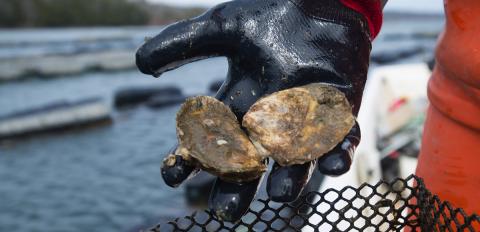Every month, we highlight an outstanding example of UNH intellectual property with excellent commercial potential. Contact unh.innovation@unh.edu for more information about any of UNH's innovations.

Assay for the detection, enumeration, and identification of human pathogenic Vibrio (Vp) in seafood
An inexpensive and reliable method for rapid Vibrio detection, which quantifies levels of dangerous pathogenic and harmless non-pathogenic Vibrio strains. The assay more accurately assesses pathogenic Vibrio risk levels throughout the seafood consumption lifecycle.
Download the Innovation Brief
Benefits:
- Flexible technology platform adaptable for field testing kit and traditional lab setting
- Quantify levels of harmful and harmless Vibrio strains for more accurate risk assessment
- Inexpensive and reliable alternative to traditional methods
Applications:
- Diagnostic field test kit
- Food safety testing
- Epidemiological monitoring and predictive modeling tool
Intellectual Property Status:
PCT/US2016/021089
Overview
Pathogenic Vibrio parahaemolyticus bacteria (Vibrio) infect shellfish and induce severe food-borne illnesses when ingested by humans. Though few cases result in death, Vibrio infections represent a significant liability for the seafood industry both in terms of public health risks and as lost revenue. Current detection methods are unreliable, time consuming and expensive, or fail to discriminate between harmless (non-pathogenic) and dangerous (pathogenic) Vibrio strains.
Researchers at the University of New Hampshire have developed a novel tiered genetic analysis method to differentiate between pathogenic and non-pathogenic strains. The new patent-pending test more accurately assesses Vibrio-related risks and can be used throughout the lifecycle of seafood, including harvesting, processing, distribution, and consumption. This distinction can benefit several markets by providing more accurate risk assessment for food inspectors, producers, wholesalers, and retailers; or provide more accurate public health information to researchers, the government, and regulatory agencies. The diagnostic test can be used in a traditional laboratory setting and can be adapted as a field testing kit.
Lead Innovator – Cheryl Whistler, Ph.D.
Dr. Cheryl Whistler is an Associate Professor in the Molecular, Cellular, and Biomedical Sciences Department at the University of New Hampshire. She is also the director of the Northeast Center for Vibrio Disease and Ecology at UNH and has received funding from the NIH, NSF, USDA/NH Agricultural Experiment Station, and the NH Sea Grant College Program for this research. Dr. Whistler earned a Ph.D. from Oregon State University, specializing in beneficial bacterial-host interaction.
Archive
-
2021
- September 2021
Betty and Barney Hill Collection
- MARCH 2021
Innovations in Aqueous Electrochemical Energy Storage Devices
-
2020
- MARCH 2020Viscoelastic Liquid Drop Generator
- February 2020IOL INTACT® Protocol Testing Software
- JANUARY 2020SIMAP®
-
2019
- AUGUST 2019
- JULY 2019
- JUNE 2019
- APRIL 2019
- MARCH 2019
- JANUARY 2019
-
2018
- DECEMBER 2018
- OCTOBER 2018
- SEPTEMBER 2018
- JULY 2018
- JUNE 2018
